

SCIENTIFIC CLASSIFICATION
COMMON NAME: African cape buffalo, cape buffalo, savanna buffalo
KINGDOM: Animalia
PHYLUM: Chordata
CLASS: Mammalia
ORDER: Artiodactyla
FAMILY: Bovidae
GENUS SPECIES: Syncerus (together horns) caffer
FAST FACTS
DESCRIPTION:
The cape buffalo is a large, dark brown to black hoofed mammal with drooping fringed ears and large curved horns.
SIZE: About 1.0-1.7 m (3.3-5.6 ft.) tall at shoulder; 2.1-3.4 m (7-11 ft.) in length
FEMALE Females are smaller than males
WEIGHT: Approximately 425-900 kg (935-2000 lb.)
DIET: Herbivore - eats tall, coarse grasses
GESTATION: Gestation lasts approximately 11.5 months; usually a single calf is born
SEXUAL MATURITY: Between 3.5-5 years
LIFE SPAN: 15-25 years
RANGE: Eastern and southern Africa. The forest buffalo, a smaller subspecies, is found in the forests of central Africa.
HABITAT: Open savannas and grasslands near a permanent source of water
POPULATION: GLOBAL Unknown
STATUS: IUCN Lower Risk/Conservation Dependent
CITES Not listed
USFWS Not listed
FUN FACTS
1. The horns of the cape buffalo are an excellent indication of age and gender. The females and young males do not have the hard shielding that protects the base of the skull in large adult males.
2. Cape buffalos are extremely social and live in large, mixed herds of up to 2000 members! Both sexes have a separate hierarchy, with males dominant over females. Members of the same subgroup will stay in direct contact with each other and will often sleep with their heads resting on one another.
3. The African buffalo, which is often confused with the Asian water buffalo, shares many of the same characteristics but is considered a separate species.
4. Cape buffalo are always within a day's walk of a water source. This is especially true in the dry season when they are eating dried grasses.
5. Cape buffalo have the reputation of being dangerous when they are cornered or injured. There are many tales told by big game hunters earlier this century of injured buffalo turning back and goring or killing the shooter.
ECOLOGY AND CONSERVATION
By living in large herds and eating tall coarse grasses, Cape buffalo play a vital role in the ecology of the grasslands. Many of the smaller grazers are unable to digest the tall grasses, and the tall grasses may prevent them from getting to the shorter, more palatable grasses in the absence of buffalo.
Competition for food sources by non-native species such as goats and cattle have challenged the native African grazers. However, the introduction of foreign diseases from non-native species remains the biggest threat. Currently the national parks of Africa are taking great steps to protect their native wildlife against Bovine Tuberculosis. While this does not have a serious effect on domestic cattle it can decimate the herds of cape buffalo and their prey species such as lion and hyena.
AFRICAN HEDGEHOG
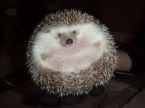

SCIENTIFIC CLASSIFICATION
COMMON NAME: African hedgehog, four-toed hedgehog
KINGDOM: Animalia
PHYLUM: Chordata
CLASS: Mammalia
ORDER: Insectivora
FAMILY: Erinaceidae
GENUS SPECIES: Atelerix albiventris (white belly)
FAST FACTS
DESCRIPTION:
A small mammal with white hair on its stomach and hair modified into spines on its back
SIZE: Adult size is 17-23 cm (6-9 in.) long
WEIGHT: Newborns weigh about 10 g (0.3 oz.) and adults weigh 270-700 g (10-25 oz.)
DIET: Insects, crustaceans, small vertebrates, eggs, carrion, and occasional plant matter
GESTATION: 34-37 days
SEXUAL MATURITY: 1-2 years
LIFE SPAN: Approximately 10 years
RANGE: Throughout Central Africa
HABITAT: Open country with low growing vegetation
POPULATION: GLOBAL Unknown
STATUS: IUCN Not listed
CITES Not listed
USFWS Not listed
FUN FACTS
1. There are 11 species of hedgehog native to Africa, Asia, and Europe, and they have been introduced to New Zealand.
2. Hedgehog quills are not barbed or poisonous. However, hedgehogs will apply a foamy saliva to their quills. This may serve many purposes: an irritant to predators, a natural insect repellent since they are unable to clean their skin well, or an attractant to potential mates.
3. A hedgehog has a large muscle running along its stomach which pulls its body into a tight, spiky little ball for defense.
4. Large owls and raptors with well-protected feet and sharp claws are some of the only natural enemies of hedgehogs.
5. Hedgehogs give birth to one to seven babies which are born with the spines just below the skin. Spines start to appear within 24 hours.
ECOLOGY AND CONSERVATION
Hedgehogs help to control insect and vermin populations. They show a high tolerance to toxins, both natural and human-made. They have been known to consume many animals whose toxins could be fatal to humans including certain beetles, wasps, bees, and venomous snakes. Hedgehogs are also a food source for some larger animals.
BLACK & WHITE COLOBUS
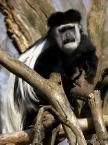

SCIENTIFIC CLASSIFICATION
COMMON NAME: Eastern black & white colobus, guereza
KINGDOM: Animalia
PHYLUM: Chordata
CLASS: Mammalia
ORDER: Primates
FAMILY: Cercopithecidae
GENUS SPECIES: Colobus (docked; they have very small thumbs, giving the appearance of being cut off) guereza (named for researcher)
FAST FACTS
DESCRIPTION:
A small monkey with a U-shaped mantle of long white fur that descends from its shoulders and around its back. White fur surrounds their black face.
SIZE:
MALE Head and body length = 675 mm (26.6 in)
Tail length = 667 mm (26.3 in)
FEMALE Head and body length = 615 mm (24.2 in)
Tail length = 687 mm (27.0 in)
WEIGHT:
MALE 13.5 kg (29.8 pds)
FEMALE 7.9-9.2 kg (17.4 - 20.3 pds)
DIET: Herbivorous; leaves, fruit, flowers, twigs
GESTATION: Approximately 6 months
SEXUAL MATURITY: 4-6 years
LIFE SPAN: Average approximately 22 years
RANGE: Africa from West Nigeria to East Tanzania and Northern Ethiopia
HABITAT: Primary and secondary forest, riverine forest, wooded grasslands; found at higher density logged forest than other primary forests
POPULATION: GLOBAL Unknown
STATUS: IUCN Not listed
CITES Appendix II
USFWS Not listed
FUN FACTS
1. Baby colobus' are born completely white.
2. Ruminant-like digestive system has enabled leaf-eaters, such as colobus', to occupy niches that are inaccessible to other primates.
3. They live in territorial groups of approximately nine individuals, based upon a single male with a number of female and their offspring.
4. The Old World monkeys of the subfamily Colobinae have a specially adapted stomach that is sacculated and supports bacterial colonies. These bacteria make it possible for digestion of cellulose in their diet of leaves, unripe fruit, and seeds.
5. There are documented cases of "allo" mothering, which means members of the troop other than the infant's biological mother care for it.
6. The differences between monkeys and apes are easy to see once you know what to look for. Apes do not have a tail and are generally larger than most other primates. They have a more upright body posture as well. Apes rely more on vision than on smell and have a short broad nose rather than a snout, as Old World monkeys do.
7. Old World monkeys are generally from Africa and Asia while New World monkeys are from the Americas. In Old World monkeys, the nostrils face downward and are narrow. New World monkeys have round nostrils facing to the side. Old World primates are usually larger than New World's. Many of the Old World monkeys are partly terrestrial.
ECOLOGY AND CONSERVATION
Colobus are important for seed dispersal through their sloppy eating habits as well as through their digestive system. In addition, they are prey for many forest predators.
Colobus struggle from the bushmeat trade, logging, and habitat destruction. In Africa, forest is often referred to as 'the bush', thus wildlife and the meat derived from it is referred to as 'bushmeat'. This term applies to all wildlife species, including threatened and endangered, used for meat. Unfortunately, nearly all African primates fall victim to the trade.
BLACK & WHITE RUFFED LEMUR


SCIENTIFIC CLASSIFICATION
COMMON NAME: black & white ruffed lemur
KINGDOM: Animalia
PHYLUM: Chordata
CLASS: Mammalia
ORDER: Primates
FAMILY: Lemuridae
GENUS SPECIES: Varecia variegata (variegated) variegata
FAST FACTS
DESCRIPTION:
Active, tree dwelling primates with catlike nose and whiskers; fur is soft with black and white patches; ears with long, thick fur; exact black and white pattern varies with location. Also called prosimians, which means "before apes". Lemurs maintain primitive primate features such as a small brain case and a prominent nose.
SIZE: Head and body length = 47.5-50 cm (19-20 in)
Tail length = 59 cm (23.6 in)
WEIGHT: 3.18-3.6 kg (7-8 lbs)
DIET: Predominantly vegetation such as flowers, fruit, seeds, nectar, and leaves
GESTATION: 90-120 days; approximately 3 offspring per birth, but up to 6
SEXUAL MATURITY: 20 months old
LIFE SPAN: 18 years or older
RANGE: Eastern Madagascar, from the Antainambalana River (northern limit) to the Mananara River (southern limit)
HABITAT: Only found in undisturbed primary rainforest
POPULATION: GLOBAL Unknown
STATUS: IUCN Not listed
CITES Appendix I
USFWS Endangered
FUN FACTS
1. Lemurs get their name from the Ancient Roman belief that they were ghosts or spirits. They were mistaken for specters because of their nocturnal, stealth habits.
2. Ruffed lemurs are quadrupedal, using all their limbs for locomotion. Their long tails allow for even better stability in the trees. In fact, most hang upside down, holding on by their feet, when feeding!
3. Lemurs rely on their sense of smell as a way of communicating with other animals. They have special scent glands on their wrists and bottoms that leave scent trails on branches to mark their territories.
4. A lemur's soft, broad fingers and toes have flat nails that allow it to grip objects and groom other lemurs.
5. These prosimians are quite social and the groups have clearly defined male and female hierarchies. Most communities number 2-5 individuals, but can reach up to 16.
6. A female lemur carries her newborn in her mouth until the baby is able to cling to the fur on mother's stomach or back.
ECOLOGY AND CONSERVATION
Lemurs fill an important ecological role of Madagascar. These primates often feed on an assortment of seasonal fruits and as they travel throughout their environment, they disperse undigested seeds in their manure within 2-3 hours. The seeds soon sprout to replenish the vegetation that sustains Madagascar's unique inhabitants. This is very important on an island where over 80% of the original habitats have been lost to logging and agriculture. The Malagasy people struggle to save their country's dwindling biodiversity. They maintain national parks to protect wildlife, support the ecotourism industry, and search for less damaging methods of farming.
CAPYBARA

SCIENTIFIC CLASSIFICATION
COMMON NAME: capybara
KINGDOM: Animalia
PHYLUM: Chordata
CLASS: Mammalia
ORDER: Rodentia
FAMILY: Hydrochaeridae
GENUS SPECIES: Hydrochaeris hydrochaeris
FAST FACTS
DESCRIPTION:
Coat is long, coarse, and somewhat sparse. Coloration on dorsal surface is reddish brown to gray, while the coloration on the ventral surface is a lighter yellow-brown. Adult males exhibit a large, bare hump atop their snout which contains rather enormous sebaceous glands. Limbs are short, while the head is large and broad. The muzzle is quite pronounced. Their digits are have short, strong claws and are partially webbed. Tail is vestigial and is therefore non-apparent.
SIZE: Head and body length = 100-130 cm (3.3-4.3 ft)
Shoulder height = up to 50 cm (1.6 ft)
WEIGHT: 27-79 kg (59.5-174.2 lb)
DIET: Mainly grasses, but also including aquatic vegetation, grains, melons, and squashes
GESTATION: 149-156 days
SEXUAL MATURITY: 15 months
LIFE SPAN: 8-12 years
RANGE: Eastern Panama through northeastern Argentina
HABITAT: Densely vegetated region adjacent to bodies of water
POPULATION: GLOBAL Unknown; stable
REGIONAL Density in the Pantanal is roughly 7 capybara per each square kilometer
STATUS: IUCN Not listed
CITES Not listed
USFWS Not listed
FUN FACTS
1. The capybara is the world's largest living rodent.
2. Capybaras are proficient swimmers, swimming with only their nostrils, eyes, and ears above the surface. They are also known to swim underwater - sometimes for considerable distances.
3. Capybaras are social animals, living in groups of 6-20 and occasionally congregating in aggregates as large as 100 individuals. Social groups are controlled by a dominant male whose social status is vigorously and aggressively maintained.
ECOLOGY AND CONSERVATION
While often hunted for its meat and hide, the capybara remains widespread and common. Commercial ranches raising capybara have seen modest interest. Capybara ranches have the ecological advantage of maintaining areas while engaging in commercial pursuits.
FENNEC FOX
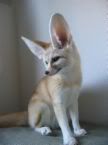

SCIENTIFIC CLASSIFICATION
COMMON NAME: fennec fox
KINGDOM: Animalia
PHYLUM: Chordata
CLASS: Mammalia
ORDER: Carnivora
FAMILY: Canidae
GENUS SPECIES: Vulpes (fox) zerda (Arabic for fennec, meaning small fox); former genus species: Fennecus (small fox) zerda
FAST FACTS
DESCRIPTION:
The fennec is the smallest of the foxes with enormous ears, a tiny face, and a pointed snout. The fennec fox is cream in color with a long (3/4 of the head and body length) black-tipped tail.
SIZE: Head and body 35-40 cm (14-16 in) long; tail 20 cm (8 in); height at the shoulders 20 cm (8 in)
WEIGHT: 1.36-1.6 kg (3-3.5 lbs.)
DIET: Mostly carnivorous; includes insects, snails, lizards, rodents, birds, eggs, and plant matter (fruits and berries)
GESTATION: Gestation lasts approximately about 50 days
SEXUAL MATURITY: Approximately 6-10 months
LIFE SPAN: Averages 10-12 years
RANGE: Northern Africa, throughout the Sahara Desert, East to the Sinai Peninsula and Arabia
HABITAT: Inhabits desert and semi-desert
POPULATION: GLOBAL Unknown
STATUS: IUCN Density Dependent
CITES Appendix II
USFWS Not listed
FUN FACTS
1. Fennec foxes have extraordinary hearing to locate prey that may be underground.
2. Their large ears, which are usually 4-6 inches long, help to dissipate excess body heat on hot days in the desert.
3. The fennec fox seems to be the only carnivore living in the Sahara Desert able to live well without free water. Their kidneys are adapted to restrict water loss, their extensive burrowing may cause the formation of dew, which can then be consumed, and they will receive moisture from the food that they eat. In addition, their burrowing and nocturnal lifestyle helps to restrict water loss. However, they will drink if water is available.
4. The fennec fox can have two litters per year if the first litter is lost and the food supply is plentiful. This is very unusual among the canids. Normally 2-5 young are born per litter.
5. Their thick fur helps to insulate them from the cold desert nights. Their sandy coloration helps to reflect heat, and also provides excellent camouflage. Fennec foxes also have thick fur on the soles of their feet, which insulate against the hot sand of the desert. This extra fur on the soles of their feet also afford them excellent traction in the loose sand.
During the day, they stay cool within the underground burrows they are so adept at creating. Thus their nocturnal behavior.
ECOLOGY AND CONSERVATION
Unfortunately, as with most living species, fennec fox populations are at risk. They are not only suffering from loss of habitat, but they are also largely hunted by the people of the Sahara, making them become rare in parts of Northwestern Africa. However, they are of no threat to people and their livestock. In fact, fennec foxes are important small hunters helping to control the populations of several pests, including rodents and locusts. The over-population of rodents poses a direct threat to the environment and agricultural crops. Consequently, fennec foxes, and other small carnivores are extremely important to the balance of many ecosystems.
GIANT ANTEATER
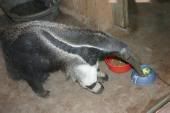
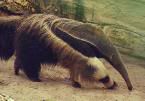
SCIENTIFIC CLASSIFICATION
COMMON NAME: giant anteater
KINGDOM: Animalia
PHYLUM: Chordata
CLASS: Mammalia
ORDER: Xenarthra
FAMILY: Myrmecophagidae
GENUS SPECIES: Myrmecophaga (to eat ants) tridactyla (three toe/finger)
FAST FACTS
DESCRIPTION:
Tapered head with a long, tubular mouth opening. They have poor vision, but excellent hearing and sense of smell. Their body is long and slender. Their coat is a coarse, dense fur with a gray coloring and a broad, diagonal black stripe edged in white running from neck and chest toward the mid-dorsal.
SIZE: head & body length: 100-120 cm (3.3-3.9 ft.)
tail length: 65-90 cm (2.1-3.0 ft.)
WEIGHT: Males may exceed 45.5 kg (100 lbs.), but are usually 20-40.9 kg (44-90 lb.); females 20% smaller
DIET: Insects such as termites, ants, beetles, insect larvae; occasionally fruit. The giant anteater fulfills it's need for water by licking wet vegetation.
GESTATION: 180-190 days; one offspring per birth
NURSING DURATION Approximately 6 months
SEXUAL MATURITY: 2-3 years
LIFE SPAN: Unknown in the wild; up to 26 years in captivity
RANGE: Southern Mexico, through Central America, and South America east of the Andes through Uruguay and northern Argentina
HABITAT: Grasslands, savannas, and open tropical forests
POPULATION: GLOBAL Unknown
STATUS: IUCN Vulnerable
CITES Appendix II
USFWS Not listed
FUN FACTS
1. Giant anteaters prey almost exclusively on social insects (i.e. ants and termites). Such dietary focus significantly shapes the physical form and behavior of the species.
2. Giant anteaters do not have teeth; instead, they have tongues can reach as much as 610 mm (2 ft.) in length! As long as the tongue is, it is relatively narrow over the entirety of its length, with its widest point being only 10-15 mm (0.4-0.6 in.). They use this giant tongue to gather insects for food, extending it up to 150 times per minute.
3. Their tongues are covered with tiny spines which point toward the back of the throat. Additionally, their tongue is coated with a thick, sticky coat of saliva (which is secreted from relatively enlarged salivary glands). Prior to swallowing, the insect-coated tongue is firmly pressed against the anteater's hard upper palate - crushing their meal and easing ingestion.
4. The stomaches of anteaters do not secrete hydrochloric acid. Instead, they depend on the formic acid content of their ant-dominated diet to aid in digestion.
5. They can eat up to 30,000 insects a day.
6. Despite their coarse fur and thickened skin (particularly about the muzzle), giant anteaters may still be agitated by the large-jawed soldier castes of the ant and termite species upon which they feed. Accordingly, they avoid soldiers both actively and tactically. The anteater's typical feeding profile could be described as a lightening strike - quick feeding action over a short period. Such a clipped feeding incursion generally outpaces a given insect colony's ability to rapidly mount a defence; thus tactically avoiding the aggrevation of soldier castes.
7. Giant anteaters tend to pursue the larger bodied social insects, while tamanduas and silky anteaters tend to prey on smaller insect fare. Such dietary segmentation allows for different anteater species to co-exist in the same region without being in direct predatory competition.
8. Giant anteaters are terrestrial. Unlike other anteater species, adult giant anteaters only rarely climb trees. Instead, its powerful forearms and prominent claws are used primarily for digging and ripping in the search for food.
9. While the giant anteater has five digits on each foot, their first digit is reduced and the second and third digits exhibit the long claws.
10. Anteaters are able to detect insects with their powerful sense of smell, 40 times that of man.
11. If threatened, the typically non-vocal giant anteater may make a bellowing noise. Additionally, they will often rear up on their hind quarters and swipe with their (up to) 10 cm (4 in.) long foreclaws.
12. Anteaters do not walk on the soles of their forefeet. Rather, they flex the digits upward and turn the forefeet inward, such that the large foreclaws do not come in contact with the ground.
13. Anteaters sleep as much as 15 hours each day.
14. As an outcome of their diet and lifestyle, anteaters have relatively low metabolic rates. As a stark example, the giant anteater has the lowest recorded body temperature of any placental mammal - 32.7° C (90.9°F).
15. When observed in regions without a significant human presence, giant eaters are diurnally active. However, giant anteaters appear to adopt a nocturnal lifestyle when living in more disturbed areas subject to human activity.
16. Giant anteaters - save for mother/young pairs - are generally solitary.
17. Usually only one baby is born at a time. It nurses for six months and is carried on the mother's back for up to a year.
ECOLOGY AND CONSERVATION
The giant anteaters are becoming quite rare due to the exotic pet trade and habitat destruction. They have all but disappeared from their historic range within Central America. In South America, they are hunted for their meat and for trophies. Some are also killed because they are mistakenly blamed in the killing of cattle and dogs. Anteaters are essential in maintaining insect populations. In addition, they are food for other larger carnivores.
GREATER KUDU
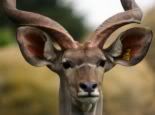
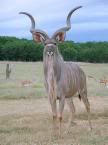
SCIENTIFIC CLASSIFICATION
COMMON NAME: greater kudu
KINGDOM: Animalia
PHYLUM: Chordata
CLASS: Mammalia
ORDER: Artiodactyla
FAMILY: Bovidae
GENUS SPECIES: Tragelaphus (goat like deer) strepsiceros (twisted horns)
FAST FACTS
DESCRIPTION:
The kudu is a large antelope with fawn coloring and thin, white, sparse vertical stripes. Greater kudu may be distinguished from similar species, lesser kudu (Tragelaphus imberbis), by presence of throat main.
MALE The male has long black twisted horns
FEMALE Females do not have horns
SIZE: Approximately 1.2-1.5 m (4-5 ft.)
WEIGHT:
MALE 225-357.7 kg (495-787 lb.)
FEMALE 180-235 kg (396-517 lb.)
DIET: Includes leaves, grass, roots, and sometimes fruits and tubers
GESTATION: Gestation lasts approximately 6-7 months; one offspring (but rarely two) at birth
SEXUAL MATURITY: 1-2 years
LIFE SPAN: Approximately 15 years in the wild
RANGE: Throughout Southern and Eastern Africa as far North as Ethiopia
HABITAT: Inhabits stony, sparsely to densely forested flat hilly and mountain country
POPULATION: GLOBAL Unknown
STATUS: IUCN Lower Risk/Conservation Dependent
CITES Not listed
USFWS Not listed
FUN FACTS
1. Kudus are one of the largest antelopes.
2. They produce one of the loudest sounds made by antelope in the form of a gruff bark.
3. Kudu horns have spirals, which allow males to spar by interlocking horns. The males then proceed to shove and twist until one opponent is knocked off balance and thrown down. Some reports show male kudus found with locked horns, even in death.
ECOLOGY AND CONSERVATION
Adult kudus are an important food source for many larger predators, such as lions and spotted hyenas. Many medium-sized carnivores prey upon kudu yearlings and calves. Newborns also serve as a food source for smaller predators.
Kudu are hunted for their horns; they are considered valuable trophies. They are also hunted for their meat as well as their reputation in some areas as pests because of occasional crop damage.
Along with these factors, kudu, largely woodland animals, suffer from habitat destruction.
LLAMA


SCIENTIFIC CLASSIFICATION
COMMON NAME: llama
KINGDOM: Animalia
PHYLUM: Chordata
CLASS: Mammalia
ORDER: Artiodactyla
FAMILY: Camelidae
GENUS SPECIES: Lama (Peruvian name for animals in the camel family) glama (name given by Linnaeus, corruption of llama)
FAST FACTS
DESCRIPTION:
The llama is a tall horse-shaped animal with a woolly coat of varying shades
SIZE: Approximately 150-180 cm (5-6 ft.)
WEIGHT: 135-202.5 kg (300-450 lbs.)
DIET: Grazer and browser; diet includes grasses and leaves
GESTATION: Gestation lasts approximately 350 days; usually one offspring
SEXUAL MATURITY: About 2 years
LIFE SPAN: Up to 20 years
RANGE: Native to western South America, mostly Bolivia, Chile, and Peru
HABITAT: Inhabits mountain terrain; also domesticated in many areas
POPULATION: GLOBAL Unknown
STATUS: IUCN Not listed
CITES Not listed
USFWS Not listed
FUN FACTS
1. Fossil footprints found in California indicate that llamas, relatives of camels, originated in North America. It is believed that the animals that moved north and crossed the Bering land bridge evolved into camels, while the ones that migrated to the south became the "lama" family.
2. Llamas make a variety of sounds. The most common sound is a humming noise. A female will hum to her cria (offspring). Males orgle, which sounds like a gurgle, during breeding. If a couple of males decide to have a fight, they will start screaming at each other. If a llama perceives danger, it sends an alarm call, which warns the rest of the herd.
3. In the wild, a male will find a high vantage point to watch over his herd of females and if he spots danger, will start alarm calling. Moments later every male in the vicinity will be alarm calling.
4. The idea that llamas spit is true. Llamas usually spit to settle an argument over food or to decide which is the dominant llama. A female will also spit at a male to tell him to get lost. They do not normally spit at humans unless they are provoked. Their body language will warn other llamas; flattened ears are a signal to back off and are usually sufficient. The next threat may be a spitting sound, but using only air.
ECOLOGY AND CONSERVATION
Also known as the "new world camel", llamas were domesticated in the early 1500s and are valuable work animals.
They, like all camelids, differ from other mammals in that their red blood corpuscles are oval instead of round. This adaptation allows them to take in more oxygen, making them well suited to life at high altitudes.
Their coat is used to make cloth and other material goods.
In the wilds of South America, pumas (or mountain lions) are llamas' only natural predator. In North America, cougars and bears have been known to take llamas.
In South America, thousands are used for meat each year.
SUGAR GLIDER
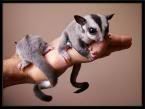

SCIENTIFIC CLASSIFICATION
COMMON NAME: sugar glider, lesser gliding opossum, sugar squirrel
KINGDOM: Animalia
PHYLUM: Chordata
CLASS: Mammalia
ORDER: Diprotodontia
FAMILY: Petauridae
GENUS SPECIES: Petaurus (springboard used by acrobats) breviceps (short)
FAST FACTS
DESCRIPTION:
The sugar glider has soft, thick, mink-like, gray fur that covers its body and tail. A black stripe runs the full length of the body in line with the spine and crown of the head. The tip of the tail is black.
SIZE: The head and body measure 125-150 cm (5-6 in.)
WEIGHT: 114-171 grams (4-6 oz.)
DIET: Primarily feeds on fruits and vegetables; occasionally eats insects, mice, nuts, and other small mammals
GESTATION: Gestation lasts approximately 16 days gestation, then they crawl into the pouch for another 10 weeks
NURSING DURATION Weaned at 16 weeks
SEXUAL MATURITY: About 9-10 months
LIFE SPAN: 4-6 years in wild
RANGE: Australia, Tasmania, New Guinea, and neighboring islands of Indonesia
HABITAT: Arboreal species, inhabits forests
POPULATION: GLOBAL Unknown
STATUS: IUCN Not listed
CITES Not listed
USFWS Not listed
FUN FACTS
1. These marsupials are able to glide up to 45 meters (148.5 ft.) and have been observed to leap at and catch moths in flight.
2. Sugar gliders live in large colonies of 20-40 individuals with two alpha males fathering the majority of offspring.
3. Young gliders usually leave around 10 months to start their own colonies.
4. Sugar gliders get their name because of the specialized flap connecting the front leg to the hind leg, giving them the ability to glide.
5. When angry, gliders lean back and make a chattering noise that resembles a small, yapping dog. If this warning doesn't work, they strike with full force.
6. Sugar gliders have opposable thumbs and four fingers on both hands and feet. Each finger has a sharp toe that can hook like Velcro to most non-slick surfaces.
7. Males have a bald spot on their head, which is actually a scent gland.
8. Females have a pouch on their belly in which they raise their young for 10 weeks after birth.
ECOLOGY AND CONSERVATION
Sugar glider populations are fairly stable and often thrive in the strips and patches of forest left on cleared agricultural land, unlike some of their opossum cousins. Retention of interconnected systems of suitable forest and woodland habitat are essential for its conservation in these agricultural areas. Their gliding locomotion is an efficient way of exploiting hard to reach patchy food sources other animals may have difficulty finding.
Due to its relatively small size, especially in its first 12 months of life, sugar gliders are a prey animal for owls, kookaburras, goannas, and cats.
WESTERN TARSIER
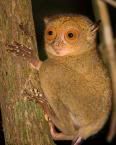
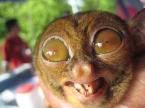
SCIENTIFIC CLASSIFICATION
COMMON NAME: western tarsier
KINGDOM: Animalia
PHYLUM: Chordata
CLASS: Mammalia
ORDER: Primates
FAMILY: Tarsiidae
GENUS SPECIES: Tarsius bancanus
FAST FACTS
DESCRIPTION:
Tarsier coloration varies between buff—gray and beige. They have long hind legs and long, skinny fingers and toes to help them climb and leap. As nocturnal animals, their huge eyes and big ears help them see and hear in the dark.
SIZE: Head and body length: 11.5 to 14.5 cm (4.5—5.7 in.)
Tail length: 20 to 23.5 cm (7.9—9.2 in.)
WEIGHT: 105 to 135 g (3.7—4.8 oz.)
DIET: Insectivorous and carnivorous, consuming a variety of insects, lizards, and other small vertebrates
GESTATION: 6 months
SEXUAL MATURITY: 1 year
LIFE SPAN: Around 8 years
RANGE: Borneo, Bangka, and southern Sumatra
HABITAT: Rainforest
POPULATION: GLOBAL no data
STATUS: Currently not listed
FUN FACTS
1. The large forward—facing eyes allow tarsiers to accurately assess distances for safe leaping. Tarsiers can leap distances up to 5.4 m (18 ft.)
2. The large eyes of the tarsier are not able to move; rather, like owls, they can turn their heads nearly 180 degrees in each direction to focus on objects.
3. Tarsiers get their name from their long tarsal (ankle) bones, which help propel them while leaping.
4. The flat, fleshy pads at the end of tarsiers’ fingers and toes allow them to climb smooth vertical surfaces.
5. Like other primates, tarsiers are exclusively predators.
6. Tarsiers live in pairs.
ECOLOGY AND CONSERVATION
Unlike the Philippine tarsier (Tarsius syrichta), which is endangered, the Western tarsier is fairly stable throughout most of its range. One of the greatest threats to tarsiers is habitat loss due to the logging industry. Tarsier populations are reduced by thousands every year, leading to their legal protection in Malaysia and Indonesia. Another threat to their survival is collection for the pet trade. These small primates require appropriate live food sources and are susceptible to several pet ailments such as tapeworms.
Tarsiers help regulate insect and small vertebrate populations since they can eat nearly 10% of their own weight each day, 10 to 14 g (0.35 to 0.5 oz.). They are also a food source for a variety of large Indonesian predators.







0 comments:
Post a Comment